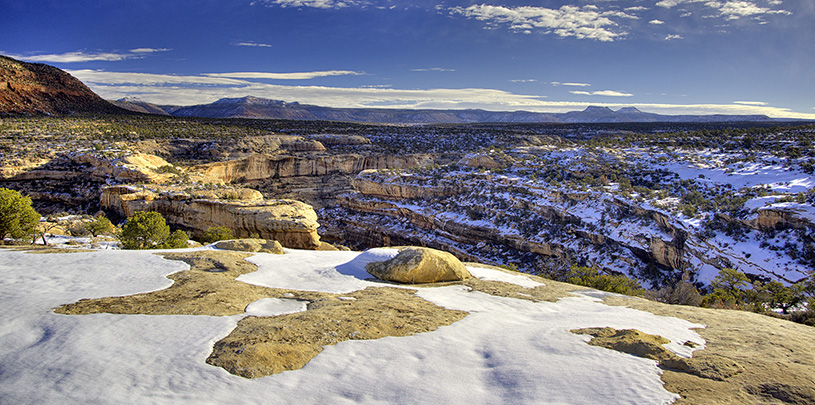
 by Tim Peterson, Cultural Landscapes Director
by Tim Peterson, Cultural Landscapes Director
What’s going on in the uranium industry and at the White Mesa Mill, near Bears Ears National Monument? Three recent developments are worth watching.
Back in 2020, we told you about the proposal to ship radioactive waste left over from rare earth element processing generated halfway around the world at NPM Silmet OÜ, in Estonia, to the White Mesa Mill on the doorstep of Bears Ears National Monument and just miles from the Ute Mountain Ute Tribe’s White Mesa community. Despite thousands of comments sent to regulators opposing the plan (if you sent a comment, thank you), the state of Utah approved the waste shipments in July 2021.
Recently obtained documents revealed that shipments from Estonia had begun to arrive at the mill by June 2022, and that more than 1.4 million pounds (660 metric tons) of waste packed into nearly 2,000 55-gallon drums had arrived by late July 2022. At that time, inspectors posted signs in the outdoor area where the drums were being stored indicating a “radiation area” out of caution, because of radiation emitted by the waste.
In an around-the-world circuit, NPM Silmet OÜ in Estonia is the same facility where Energy Fuels sends its new intermediate rare earth element product for further processing.
We learned late last year that the owner of the White Mesa Mill, Energy Fuels Resources, had been awarded a multimillion-dollar contract by the Department of Energy to supply uranium oxide for the nation’s strategic uranium reserve, a project funded by a one-time $75 million sum slipped in the final funding bill passed under President Trump.
Despite opposition from the Ute Mountain Ute Tribe, whose White Mesa community sits just a few miles down the road from the White Mesa Mill, the Department of Energy awarded the contract to Energy Fuels in December 2022. Energy Fuels plans to pocket $18.5 million in taxpayer dollars from the sale of existing uranium inventory it holds at a facility in Metropolis, Illinois. That facility has previously shipped radioactive waste for processing and final disposal at the White Mesa Mill.
Thankfully, no new mining or milling is necessary for Energy Fuels to fill the Department of Energy’s present order, but the government contract does support the company that runs the White Mesa Mill and Pinyon Plain uranium mine (formerly called Canyon Mine) near the Grand Canyon. Both operations are actively opposed by nearby Indigenous communities who view the company’s mining and milling activities as a threat to their homes and their future. What’s more, future mining (likely near the Grand Canyon) and milling may be triggered should uranium prices continue to climb or should the industry’s friends in Congress convince lawmakers to set aside more federal money for domestic uranium producers.
A bill to further prop up American uranium mining died in the last Congress, but similar bills are likely to be introduced again. Where would milling American uranium take place? You guessed it: at the White Mesa Mill. Unless a mining executive with a history of promoting a uranium mill that never got built has his way.
"[C]onfident that the uranium market is in the early stages of a sustained upswing," in January 2023, George Glasier, CEO of Western Uranium and Vanadium, announced plans to build a new uranium mill in Utah near the town of Green River, in an industrial complex whose other improbable tenants would include a new nuclear power plant and a new oil refinery.
Glasier was CEO of Energy Fuels in the mid-2000s when the company proposed building a new uranium mill called Piñon Ridge just over the border from Utah in Colorado’s Paradox Valley. Plans to build the Piñon Ridge Mill went through a lengthy permitting process. Colorado regulators issued an operating license in 2011. Opponents sued, and by 2018, a judge had rescinded the permit.
By then Energy Fuels had bought the company that owned the existing White Mesa Mill, uranium prices had plummeted, and construction on the Piñon Ridge Mill never broke ground. Time will tell if that same “promote, permit, scrap” process will repeat, but in the meantime it looks like Glasier is beating the bushes for investors.
We’ll be following plans to build a new uranium mill in Utah closely, and we’ll let you know when the public has the chance to weigh in.
Act now. Urge decision-makers to protect the Bears Ears cultural landscape from radioactive waste.
Utah voters strongly support national monuments in general, and Bears Ears and Grand Staircase-Escalante in particular, a new poll shows.
Read MoreA small victory in the legal case challenging Daneros uranium mine, near Bears Ears National Monument.
Read MoreBears Ears petroglyph panels and cultural sites protected by new proposed management plan.
Read More